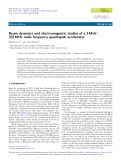
REGULAR ARTICLE
Beam dynamics and electromagnetic studies of a 3 MeV,
325 MHz radio frequency quadrupole accelerator
Rahul Gaur
1,2,*
and Vinit Kumar
1,2
1
Homi Bhabha National Institute, Mumbai 400094, India
2
Raja Ramanna Centre for Advanced Technology, Indore 452013, India
Received: 27 June 2017 / Received in final form: 16 December 2017 / Accepted: 1 March 2018
Abstract. We present the beam dynamics and electromagnetic studies of a 3 MeV, 325 MHz H
radio frequency
quadrupole (RFQ) accelerator for the proposed Indian Spallation Neutron Source project. We have followed a design
approach, where the emittance growth and the losses are minimized by keeping the tune depression ratio larger than
0.5. The transverse cross-section of RFQ is designed at a frequency lower than the operating frequency, so that the
tuners have their nominal position inside the RFQ cavity. This has resulted in an improvement of the tuning range, and
the efficiency of tuners to correct the field errors in the RFQ. The vane-tip modulations have been modelled in CST-
MWS code, and its effect on the field flatness and the resonant frequency has been studied. The deterioration in the field
flatness due to vane-tip modulations is reduced to an acceptable level with the help of tuners. Details of the error study
and the higher order mode study along with mode stabilization technique are also described in the paper.
1 Introduction
Since its invention in 1970 [1] and first demonstration in
1974 at the USSR Institute for High Energy Physics in
Protvino, the radio frequency quadrupole (RFQ) has been
established as a popular choice for acceleration of a high
intensity ion beam in the very low velocity regime of about
0.01–0.08 times the speed of light. The Indian Spallation
Neutron Source (ISNS) proposed to be developed at Raja
Ramanna Centre for Advanced Technology, India will use
a 1 GeV H
injector linac and accumulator ring to produce
a high flux of pulsed neutrons via spallation process. The
low energy front-end of this linac will comprise of a
325 MHz RFQ [2,3]. Main design parameters of the RFQ
are listed in Table 1. It is desired that the RFQ accelerates a
beam current up to 15 mA of H
particles from 50 keV to
3 MeV. This beam will be further accelerated to 1 GeV by
independently phased superconducting cavities.
High energy section in the injector linac of ISNS is
based on 325 MHz single spoke resonators followed by
650 MHz superconducting elliptical cavities. Hence, the
most preferable choice for the frequency of RFQ is either
325 MHz or 162.5 MHz, to ease the frequency transition in
the linac. The higher frequency option of 325 MHz has an
advantage over the option of 162.5 MHz that the RFQ will
have shorter length and compact transverse size with
higher limit of Kilpatrick field. On the other hand, the
larger size of the accelerating structure in the case of lower
frequency option could be an advantage for CW machines
from the cooling point of view due to lower power density
at the surface. This is however not an important issue for
us since our design is for the pulsed operation. Moreover,
the availability of high power RF source is an important
issue while choosing the operating frequency. For ISNS, it
is planned to use indigenously developed solid state RF
power sources at 325 MHz. Therefore, the operating
frequency of the RFQ has been chosen to be 325 MHz.
At this frequency, the RFQ electrodes are selected to be
vane type due to higher efficiency than that of rod type
electrodes.
In this paper, we present a detailed analysis leading to
the choice of the beam dynamics parameters in the RFQ
structure, and also provide a physical explanation of the
results. We would like to emphasize that we did not employ
the equipartitioning condition in the design of our RFQ,
which is widely used to avoid the emittance exchange
between transverse and longitudinal planes due to coupling
resonances driven by space-charge in the high current
anisotropic beams. In this paper, we have observed that the
lack of equipartitioning condition and the resonance
crossing are not serious problems from the beam dynamics
point of view, as long as we maintain the value of tune
depression ratio larger than 0.5, i.e., the beam is not space-
charge dominated. As the design current in our case is only
15 mA, we did not prefer equipartitioned design, which is
more complex than the conventional approach, where we
have kept the average aperture radius constant.
*e-mail: rahul@rrcat.gov.in
EPJ Nuclear Sci. Technol. 4, 9 (2018)
©R. Gaur and V. Kumar, published by EDP Sciences, 2018
https://doi.org/10.1051/epjn/2018004
Nuclear
Sciences
& Technologies
Available online at:
https://www.epj-n.org
This is an Open Access article distributed under the terms of the Creative Commons Attribution License (http://creativecommons.org/licenses/by/4.0),
which permits unrestricted use, distribution, and reproduction in any medium, provided the original work is properly cited.





















